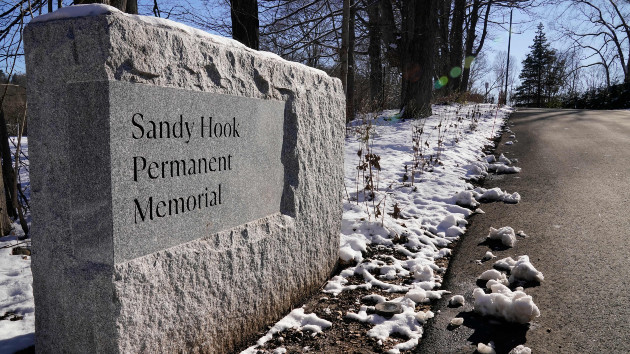(NEWTON, Conn.) — Two days after the mass shooting at Sandy Hook Elementary School, then-President Barack Obama approached a podium to speak. Before him was a room of people in shock over what had occurred in their quiet Connecticut town.
On Dec. 14, 2012, a 20-year-old gunman walked into the school in Newtown and fatally shot 20 young students and six educators.
“Here in Newtown, I come to offer the love and prayers of a nation,” the president told the families and community members gathered.
Now, those precise words stand etched in stone, welcoming visitors to the Sandy Hook Permanent Memorial, created in memory of those who lost their lives 10 years ago in the nation’s worst mass shooting at an elementary school.
The memorial took a decade to achieve, in part because of the meticulous process the memorial’s planning committee took to honor the victims and their families.
“We had one chance to get it right,” said Alan Martin, vice chairman of Sandy Hook Permanent Memorial Commission. “So, we labored over the process of site selection and labored over the process of design selection. And we knew it had to be both a natural feeling, a gentle feeling, and it had to give people an opportunity to grieve.”
The memorial opened in November in advance of the anniversary. Planners and community leaders hope the site will commemorate the lives lost even as the debate over gun violence continues across the nation.
“We thought after Sandy Hook, this would make a difference in terms of responsible and reasonable gun control,” said Martin. “We really had hope that the world might change, the country might change.”
In the immediate aftermath of the tragedy, hundreds of temporary memorials sprung up all over town, flooding it with candles, flowers, teddy bears, toys and pictures. But town leaders decided the memorials couldn’t remain forever and decided to clear them by the end of 2013.
Recognizing the significance of those mementos, they chose to incinerate them into “sacred soil.” Today, that soil lives at the memorial beneath the plaque and granite stone marked with Obama’s words.
That year, the town’s council — known as the Board of Selectmen — decided to appoint a commission to figure out how best to design and build a permanent memorial to honor the lives lost. Twelve community members were appointed, including three parents who lost children, forming the Sandy Hook Permanent Memorial Commission.
Daniel Krauss, chairman of the commission, told ABC News the first question they were tasked with was, “Should a permanent memorial exist?”
After community conversations involving victims’ families, teachers, parents of students, paramedics and the general public, the answer was yes.
Krauss, along with the commission’s vice chairman Martin, said they tried to make decisions through consensus. Family input, Krauss said, was paramount but would not be the only aspect taken into consideration — they also needed a town vote to approve the $3.7 million project. Later, the State of Connecticut Bond Commission approved a $2.5 million grant which covered about 70% of costs.
After five years of site proposals and rejections, the trustees of the Boys Social and Athletic Club of Sandy Hook donated the current five-acre site, less than a mile away from the new Sandy Hook Elementary, which reopened in a brand-new building on the original property.
“You could hear them laughing and running and jumping,” Martin said, pointing out how close the memorial grounds are to the school’s playground. “When you hear the kids running…right through the trees, it’s amazing. And that’s part of the beauty of such a site.”
The commission selected a concept by Dan Affleck and Ben Waldo of SWA Design out of 188 submissions, determining that the designers’ concept fit in with their own. The planning guide stipulated “the memorial should not be physically imposing or ideologically overbearing, but through its simplicity should communicate the great depth of our loss.”
Affleck and Waldo envisioned a space that would grow with visitors over time, focusing on three primary features — a circle, path and tree — according to SWA. At the center of the memorial sits a granite basin with water, where a young sycamore was planted to symbolize the youth of children killed. Each victim’s name is engraved to the granite basin, where the water’s motions reflect a continuous energy between the living and the deceased. The paths surrounding allow visitors to choose their own route — symbolic for the journey of grief.
A mother of one of the victims visits daily, Martin said. Other family members of the victims attended the private dedication ceremony. And still, some are not comfortable visiting the memorial.
“We know some of the families would never come there,” said Martin. “Many will come here once, and many will come here whenever it is personal to them.”
Martin said the extensive process that led to the memorial holds lessons for communities in other places, such as Uvalde, Texas, where 19 students and two of their teachers were killed during a shooting at Robb Elementary School nearly seven months ago.
“We have gotten so many calls from people, from communities, that have had loss,” said Martin, “and people wanted to know our process. It was a slow, deliberate process. Every step of the way, we consulted with the families and we knew of sensitivity and deference.”
In Sandy Hook, as visitors depart the memorial on the same path they entered, they are once again reminded of the former president’s words from that Dec. 10 years ago: “I can only hope it helps for you to know that you’re not alone in your grief; that our world too has been torn apart; that all across this land of ours, we have wept with you.”
Copyright © 2022, ABC Audio. All rights reserved.












